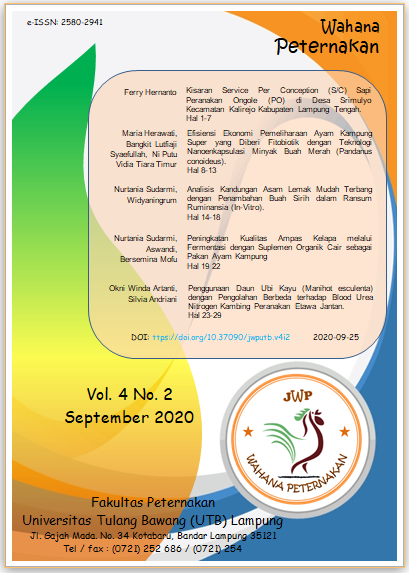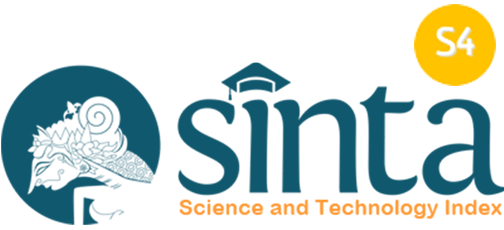Penggunaan Daun Ubi Kayu (Manihot esculenta) dengan Pengolahan Berbeda terhadap Blood Urea Nitrogen Kambing Peranakan Etawa Jantan
DOI:
https://doi.org/10.37090/jwp.v4i2.213Abstract
The objective of this experiment was to evaluate the effect of fresh, dried or silage cassava leaf to the blood urea nitrogen (BUN) of male Etawa Crossbreed (EC) goats. Twelve EC goats (grouping based on body weight with a weight range K1: 19-20 kg; K2: 20-21 kg; K3: 21-22 kg; K4: 22 kg) were allocated in housed individually throughout 90-day trial duration (14 days for animal's adaptation to the experimental diets and 7 days of faeces collection). Experimental design was randomized complete block design consisted of 3 treatments and 4 replications: concentrate + fresh cassava leaf (P0); concentrate + dried cassava leaf (P1); and concentrate + silage cassava leaf (P2). Concentrat was given at level of 50% (3% BW) and forage was given ad libitum respectively for each treatments. Variables observed were crude fiber intake, crude fiber digestibility, crude protein digestibility and blood urea nitrogen (BUN). Data were analyzed using analysis of variance (ANOVA), if there were significant effect of treatments were continued using duncan multiple range test. The results of this experiment showed that the processing of cassava leaves increased on crude fiber intake, crude fiber and crude protein digestibibility, but did not effect on blood urea nitrogen (BUN). In conclusion, processing of cassava leaves improved the consumption, digestibility but did not effect on blood urea nitrogen (BUN) of EC goats.
Keywords: Blood Urea Nitrogen, Cassava Leaf, Male Etawa Crossbreed Goat
Downloads
References
[BPS] Badan Pusat Statistik. 2015. Produksi Ubi Kayu Menurut Provinsi (ton), 1993-2015. https://www.bps.go.id. [10 April 2018].
[BPS] Badan Pusat Statistik. 2016. Populasi Ternak Kambing Menurut Kabupaten/Kota di Provinsi Lampung 2014-2016. https://lampung.bps.go.id. [09 April 2018].
Coles EH. 1986. Veterinary Clinical Pathology 4 th Ed. Philadelphia (US): W.B. Saunders Co.
Despal, Permana IG, Safarina SN, dan Tata AJ. 2011. Penggunaan Berbagai Sumber Karbohidrat Terlarut Air untuk Meningkatkan Kualitas Silase Daun Rami. Media Peternakan. 34(1): 69-76.
Kearl, L.C. 1982. Nutrient Requirements of Ruminants in Developing Countries.International Feedstuffs Utah Agriculture Experiment Station. 1st Ed. Utah(US): State University, Logan.
Kramer JW. 2000. Schlam’s Veterinary Hematology. Philadelphia (US): William & Wilkins.
Latif S. dan Mueller J. 2015. Potential of cassava leaves in human nutrition a review:Trends in Food Science and Technology. 44:147–158.
[NRC] National Research Council. 2007. Nutrient Requirment of Small Ruminants. Washington, DC (US): National Academies Press.
Peter R, Cheeke, Dierenfeld ES. 2010. Comparative Animal Nutrition and Metabolism. Cambridge (USA): Cambridge University Pr.
Puspitang I. 2015. Performa, status nutrisi dan karakteristik fermentasi rumen pada domba yang dipelihara peternak desa Petir kecamatan Dramaga Kabupaten Bogor: penelitian lapang [tesis]. Bogor (ID): Institut Pertanian Bogor.
Ranjhan SK. 1977. Animal Nutrition and Feeding Practices in India. New Delhi (IND): Vikas Publishing House PVT Ltd.
Riswandi, Muhakka, Lehan M. 2015. Evaluasi Nilai Kecernaan Secara In Vitro Ransum Ternak Sapi Bali yang Disuplementasi dengan probiotik Bioplus. Jurnal Peternakan Sriwijaya 4(1): 35-46.
Sudarman A, Hayashida M, Puspitaning IR, Jayanegara A, Shiwachi H. 2016. The use of cassava leaf silage as a substitute for concentratefeed in sheep. Trop Anim Health Prod. 48(7): 09-12.
Tillman AD, Hartadi H, Reksohadiprodjo S, Prawirokusumo S, Lebdosukojo S. 1989. Ilmu makanan ternak dasar. Yogyakarta (ID): Gajah Mada University Press.









